
Watch the Video Clip
[Contact us for full version]
![]()
![]()
It was a great research trip to Sandakan, Borneo for my new piece about death marches at the end of World War 2 with the Japanese military regime trying to dispose of the POWs from Britain and Australia.
We first went to Labuan where the Japanese surrender happened for Borneo.
There is a Peace Park there built by the Japanese and also a war cemetery for allied forces, POWs and locals who died during World War 2. The remains of the POWs who died at Sandakan (1787 of them), were finally transferred to Labuan, as the peace park built by the Japanese is also the site of the Japanese war crimes trials at the end of the war. It is also reputed be the first secret landing site of the Japanese forces when they first arrived in Borneo in 1941.
All the performers did a memorial happening for the dead POWs of Sandakan. It was a stormy morning so kabuki dance performer, Gojo Masanosuke ended up dancing in the rain - he danced from sotoba komachi around a central cross, which is the heart of the Labuan war cemetery - very moving.
 |
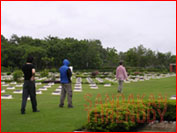 |
 |
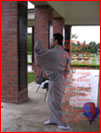 |
After that, we journeyed to Sandakan, which is presently a decaying town but it was the capital during the war and in its heyday it was known as the Hong Kong of Borneo. In the 60s there were more millionaires per square mile than anywhere else in Southeast Asia!! This town was also famous for its karayuki-sans. We saw the former house number 8 and visited the Japanese cemetery where they buried karayukis, some Japanese soldiers and other Japanese who had lived in Sandakan More importantly we went to the Sandakan memorial where formerly there was a big POW camp with about 2500 POWs. This was where the death march began. At the end of the war, an order was given to destroy the entire POW camp, and out of the whole camp, only 6 survived. They survived only because they escaped. The deaths that occurred at the camp came from daily brutality, from the death march and from final orders to exterminate the POW camp.
Over the next two days, we traced the death march route which is now a three hour expressway ride on a bus. However, we took two days as we detoured off the highway at all the important Japanese camps to explore the villages, to interview the older folk who could still remember the war. The original death marches took between 17 - 28 days to complete. The POWs and the Japanese guards had to climb up to the height of 4000 feet - huge mountain ranges including the famous Mount Kinabalu. The POWs who survived, called the walk hell in paradise – so beautiful was the landscape. The weather was terrible in that we were caught in endless rain during the filming. However, this was the real situation as well in 1945 at the end of the war when the death marches began.
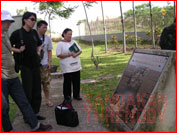 |
 |
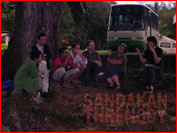
|
|
We were lucky in that we managed to track down four local survivors who are all now in their seventies. Their stories were dignified, confusing and sobering.
We also took the boat down the Tampias river which was part of the death march. Unfortunately the river was too shallow as it was not the wet season and we ended up taking a hard and long time filming it.
 |
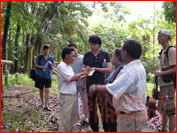 |
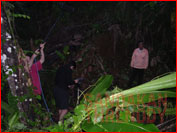 |
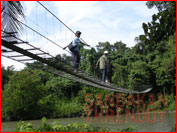 |
Finally we arrived at the end of the death march - Ranau that is today a small church. However, I found it lyrical – a small space of personal memory, rather than the formal public memorial site of Sandakan. An anti climax in a way but in many other ways it was finding the personal in this historical march, which was very important for me, and I think also the performers.
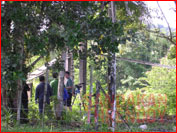 |
 |
 |